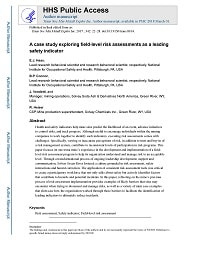Mining Publication: A Case Study Exploring Field-Level Risk Assessments as a Leading Safety Indicator
Original creation date: February 2018
Authors: E Haas, B Connor, J Vendetti, J Heiser
Health and safety indicators help mine sites predict the likelihood of an event, advance initiatives to control risks, and track progress. Although useful to encourage individuals within the mining companies to work together to identify such indicators, executing risk assessments comes with challenges. Specifically, varying or inaccurate perceptions of risk, in addition to trust and buy-in of a risk management system, contribute to inconsistent levels of participation in risk programs. This paper focuses on one trona mine’s experience in the development and implementation of a field-level risk assessment program to help its organization understand and manage risk to an acceptable level. Through a transformational process of ongoing leadership development, support and communication, Solvay Green River fostered a culture grounded in risk assessment, safety interactions and hazard correction. The application of consistent risk assessment tools was critical to create a participatory workforce that not only talks about safety but actively identifies factors that contribute to hazards and potential incidents. In this paper, reflecting on the mine’s previous process of risk-assessment implementation provides examples of likely barriers that sites may encounter when trying to document and manage risks, as well as a variety of mini case examples that showcase how the organization worked through these barriers to facilitate the identification of leading indicators to ultimately reduce incidents.

- Defining Risk Perception and Tolerance Within a Decision Science Framework
- Focus on Prevention: Conducting a Fire Risk Assessment
- Major Hazard Risk Assessment Applied to Pillar Recovery Operations
- Mapping Hazards with Microseismic Technology to Anticipate Roof Falls - A Case Study
- Optimizing Secondary Roof Support with the NIOSH Support Technology Optimization Program (STOP)
- Practical Risk Assessment Guidelines for Identifying, Assessing, and Mitigating Stored Energy Hazards in Underground Coal Mines During and After a Mine Emergency
- SPONCOM - A Computer Program for the Prediction of the Spontaneous Combustion Potential of an Underground Coal Mine
- Technology News 513 - Coaching Workshop for On-the-Job Trainers
- Technology News 545 - NIOSH Updates Spontaneous Combustion Assessment Software
- Using Major Hazard Risk Assessment to Appraise and Manage Escapeway Instability Issues: A Case Study